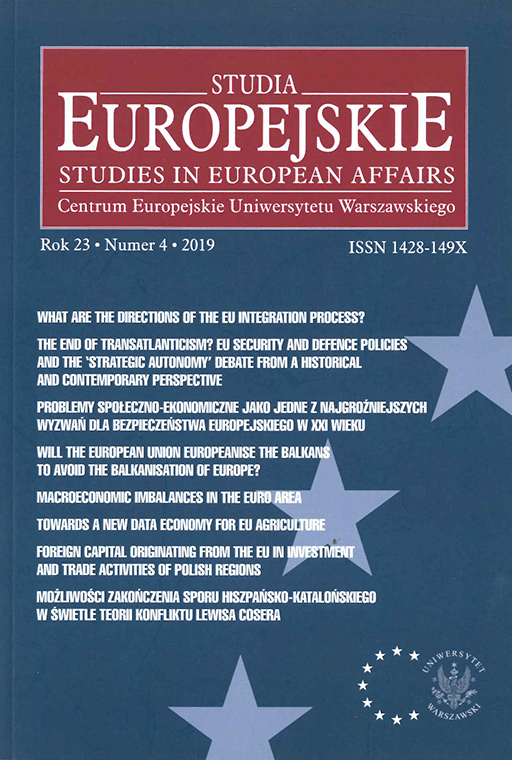
ISSUE: 4/2019
- Volume 23
- Number 4
- 2019
Subscribe NEWSLETTER
Studia Europejskie –
Studies in European Affairs
ISSN: 1428-149X
e-ISSN: 2719-3780
License
Articles published in the journal are under a Creative Commons Attribution – Non Commercial – No Derivatives 4.0 International License
Macroeconomic Imbalances in the Euro Area
Abstract
Macroeconomic imbalances constitute one of the most important threats to the cohesion of the monetary union. The aim of this article is to examine the current state of imbalances using the new composite indicator of macroeconomic stability. The calculated composite indicators of macroeconomic stability allow for the formulation of the following interpretations regarding changes and the current level of macroeconomic imbalances in the Euro area: 1. The aggregate pressure from macroeconomic imbalances in the Euro area is currently the lowest in the whole period for which data is available; 2. The imbalances in the Euro area have been partially limited, but more precisely, it should be said that they have changed their face rather than disappeared; 3. A significant reduction of imbalances occurred in the case of variables which, in the majority of interpretations, were directly blamed for the exacerbation of the post-2008 crisis phenomena: current account balance, unit labour costs, or credit growth. At the same time, imbalances in terms of international net investment position and public and private debt, as well as imbalances in the labour market, have signifi cantly increased.
References
Acedański J., Pietrucha J., Level and dynamics of financial depth: consequences for volatility of GDP, “Applied Economics”, Vol. 51, No. 31/2019, pp. 3389–3400, DOI: https://doi.org/10.1080/00036846.2019.1578857.
Arcand J.L., Berkes E., Panizza U., Too much finance?, “Journal of Economic Growth”, Vol. 20, No. 2/2015, pp. 105–148, DOI: https://doi. org/10.1007/s10887-015-9115-2.
Blanchard O., Giavazzi F., Current Account Deficits in the Euro Area: The End of the Feldstein-Horioka Puzzle?, “Brookings Papers on Economic Activity”, Vol. 33, No. 2/2002, pp. 147–210, DOI: https://doi.org/10.1353/ eca.2003.0001.
Bracke T. Bussière M., Fidora M., Straub R., A Framework for Assessing Global Imbalances, “The World Economy”, Vol. 33, No. 9/2010, pp. 1140– 1174, DOI: https://doi.org/10.1111/j.1467-9701.2010.01266.x.
De Grauwe P., The legacy of the Eurozone crisis and how to overcome it, “Journal of Empirical Finance”, Vol. 39, December 2016, pp. 147–155, DOI: https://doi.org/10.1016/j.jempfi n.2016.01.015.
Ederer S., Reschenhofer P., Macroeconomic imbalances and structural change in the EMU, “Structural Change and Economic Dynamics”, Vol. 46, September 2018, pp. 59–69, DOI: https://doi.org/10.1016/j. strueco.2018.04.002.
Febrero E., Uxó J., Bermejo F., The financial crisis in the eurozone: a balance-of-payments crisis with a single currency?, “Review of Keynesian Economics”, Vol. 6, No. 2, pp. 221–239, DOI: https://doi.org/10.4337/ roke.2018.02.04.
Handbook on Constructing Composite Indicators: Methodology and User Guide, OECD, Paris 2008.
Lane P.R., McQuade P., Domestic Credit Growth and International Capital Flows, “The Scandinavian Journal of Economics”, Vol. 116, No. 1/2014, pp. 218–252, DOI: https://doi.org/10.1111/sjoe.12038.
Pierluigi B., Sondermann D., Macroeconomic imbalances in the euro area: where do we stand?, “ECB Occasional Paper Series”, No. 211/2018.
Pietrucha J., Czech-Rogosz J., Tusińska M., Nierównowaga zewnętrzna krajów strefy euro, Wydawnictwo Uniwersytetu Ekonomicznego w Katowicach, Katowice 2013.
Pietrucha J., Kryzys w strefi euro jako tło zmian w zarządzaniu gospodarczym, in: Zarządzanie gospodarcze w strefie euro, eds. J. Pietrucha, J. Żabińska, Difin, Warszawa 2014.
Schmitz B., von Hagen J., Current account imbalances and fi ancial integration in the euro area, “Journal of International Money and Finance”, Vol. 30, No. 8/2011, pp. 1676–1695, DOI: https://doi.org/10.1016/j.jimonfi n.2011.08.003.
The eurozone crisis a consensus view of the causes and a few possible remedies, eds. R. Baldwin, F. Giavazzi, CEPR, London 2015.
The Macroeconomic Imbalance Procedure: rationale, process, application: a compendium, European Commission & Directorate-General for Economic and Financial Affairs 2016, http://ec.europa.eu/economy_fi-nance/publications/eeip/pdf/ip039_en.pdf (access 1.05.2019).
Unger R., Asymmetric credit growth and current account imbalances in the euro area, “Journal of International Money and Finance”, Vol. 73, May 2017, pp. 435–451, DOI: https://doi.org/10.1016/j.jimonfi n.2017.02.017.
Wyplosz C., The Eurozone Crisis and the Competitiveness Legend, “Asian Economic Papers”, Vol. 12, No. 3, pp. 63–81, DOI: https://doi.org/10.1162/ ASEP_a_00238
DOI: 10.33067/SE.4.2019.5
Language: English
Pages: 73-90
How to Cite:
Harvard
Pietrucha, J. (2019) "Macroeconomic Imbalances in the Euro Area". Studia Europejskie – Studies in European Affairs, 4/2019, pp. 73-90. DOI: 10.33067/SE.4.2019.5